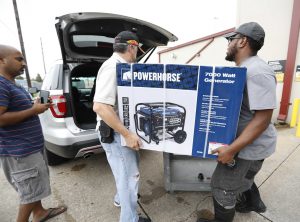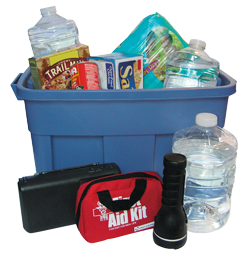
As residents of Florida, we know there is a chance each year we could experience the discomforts associated with the aftermath of hurricane winds and it is important to be prepared. Having lived in Florida for over 30 years and in Ocala for 23 years I have experienced four hurricanes that caused some level of disruption in my daily routine. The typical discomfort comes from a loss of electricity which is taken for granted when we have it, but is immediately and sorely missed when we don’t. The outlier in my experience was Hurricane Andrew, which left us without power six weeks, but also caused extensive damage to our home, office and the agricultural industry I serve in my employment. Subsequent storms have been much less severe including Hurricane Charley in 2004 (no electricity 7 days), Hurricane Frances in 2004 (no electricity 7 days) and Hurricane Irma in 2017 (no electricity 6 days). So apart from Andrew, I have been without electricity 20 days over my 30 years of living in Florida – not too bad. I have always admired and appreciated the diligence employees from the power companies show in getting citizens bask on-line as quickly as possible. As Floridians, it is important for us to be prepared for storms so we can take responsibility for ourselves.
First Considerations
Some elements of preparation should be done prior to the start of the storm season. A first consideration is deciding if you will stay in your home, if you will stay with someone else or if you will seek safety in a public shelter. Remember there is nothing glamorous about a public shelter; this should be a last resort in your planning. Next obtain supplies that will be needed in the event of a storm and which will keep through the season. High on the list is food that does not need to be refrigerated or cooked and 1 gallon of water per person per day for up to seven days. Other items of importance include a battery operated radio, flashlights and replacement batteries, comfortable sleeping items and toiletries, a first aid kit including basic first aid supplies and a supply of prescription drugs, tools for basic home repair and insect repellent. After taking care of basic needs, items to be done prior to the start of the season include taking pictures of your property as these “before” pictures will be needed in the event of an insurance claim. Be sure to print and store pictures so you will have a hard copy to share with the insurance adjuster. Gather important documents (medical records, insurance forms, social security cards, etc.), place in a waterproof container and store these in a safe place. Interior rooms such as closets with no windows are good candidates for this and purchase of a small safe for document storage may be a consideration.
Beyond the Essentials
Beyond essentials, there are secondary items that warrant consideration. These are items that would be good to have after a storm and which are not likely to be available or available only after a long wait in line. Consider a large tarp for use in patching roof leaks and roofing nails to secure it. Ice will be in demand and in short supply, so a large cooler may be a consideration. A grill, complete with a boiler plate is not a necessity, but is surely handy to have following a storm. Paper goods – plates, cups and plastic knives, forks and spoons as well as a supply of towelette wipes and napkins will save the need to wash dishes. Finally, a good roll of duct tape seems to lend itself to many uses during and after a hurricane.
 With advances in weather forecasting there is generally greater notice of potential landfall of a storm, although the eventual path of a hurricane is always uncertain. If a storm is projected for your area, a few days prior to the storm insure your vehicle has a full tank of fuel, consider withdrawing a supply of cash for emergency purchases, be sure you have gas for your generator if you have one and remember to stock up on any needed pet supplies. Let relatives, particularly if they live in other states, know where you expect to be for the storm and your immediate plans for the post storm period. Secure any loose items in your yard and immediately prior to the storm fill the bathtub with a supply of water. Check with neighbors to determine what plans they have for riding out the storm; remember that in times of trial it is important for neighbors to band together to help one another pull through tough circumstances. Open the door to those relationships before a storm strikes.
With advances in weather forecasting there is generally greater notice of potential landfall of a storm, although the eventual path of a hurricane is always uncertain. If a storm is projected for your area, a few days prior to the storm insure your vehicle has a full tank of fuel, consider withdrawing a supply of cash for emergency purchases, be sure you have gas for your generator if you have one and remember to stock up on any needed pet supplies. Let relatives, particularly if they live in other states, know where you expect to be for the storm and your immediate plans for the post storm period. Secure any loose items in your yard and immediately prior to the storm fill the bathtub with a supply of water. Check with neighbors to determine what plans they have for riding out the storm; remember that in times of trial it is important for neighbors to band together to help one another pull through tough circumstances. Open the door to those relationships before a storm strikes.
During a hurricane check frequently under doors for incoming rain. These storms are wind-driven rain and you will find winds force water into places it never reaches, even in the severest of summer storms. Resist the temptation to venture outside until the storm has passed. When you do venture outside remember to wear close-toed shoes. Avoid any downed power lines and areas of standing water. Check overhead for any dangers before venturing under trees, sheds or other structures. Take someone with you or at least be sure someone knows where you will be and when you expect to be back.
None of us wants the damages and inconveniences associated with a hurricane, but as Floridians we must expect these from time to time. Making the effort to prepare in advance of a storm will make it easier to get through this time of disruption in your life.
 0
0
